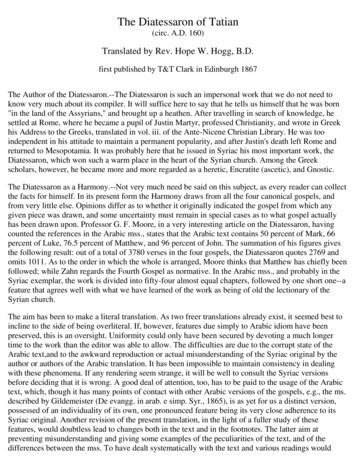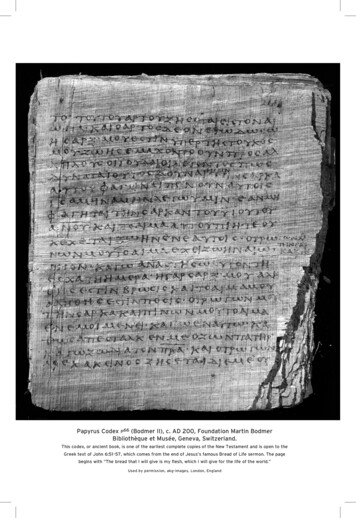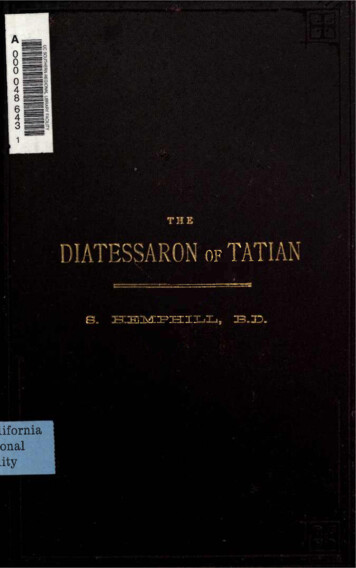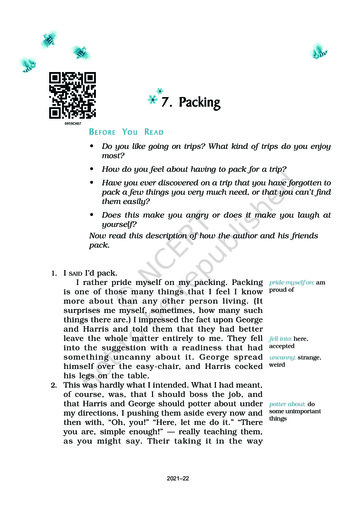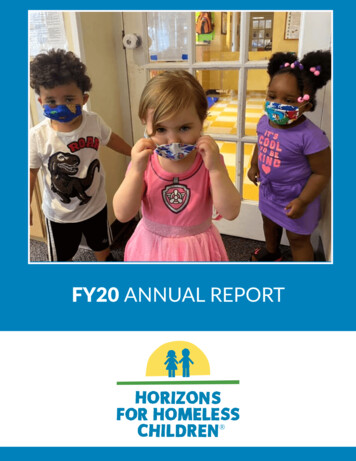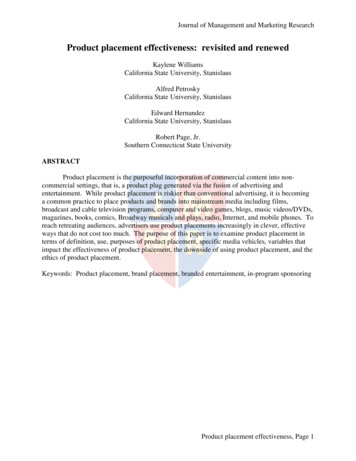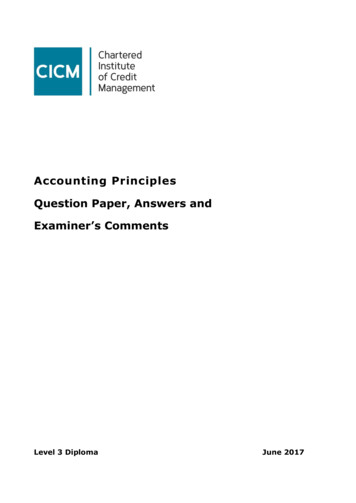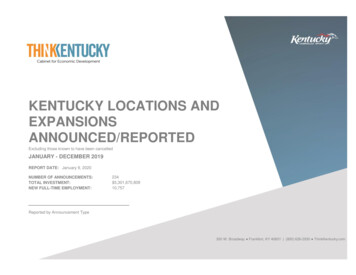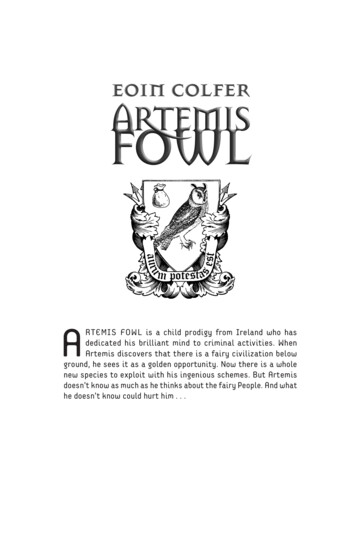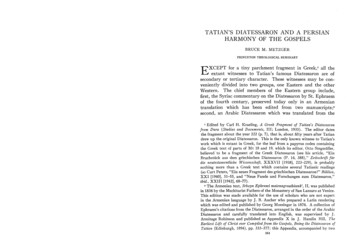
Transcription
TATIAN'S DIATESSARON AND A PERSIANHARMONY OF THE GOSPELSBRUCE M. METZGERPRINCETON THEOLOGICAL SEMINARYfor a tiny parchment fragment in Greek,' all theE. XCEPTextant witnesses to Tatian's famous Diatessaron are ofsecondary or tertiary character. These witnesses may be conveniently divided into two groups, one Eastern and the otherWestern. The chief members of the Eastern group include,first, the Syriac commentary on the Diatessaron by St. Ephraemof the fourth century, preserved today only in an Armeniantranslation which has been edited from two manuscripts;'second, an Arabic Diatessaron which was translated from theI Edited by Carl H. Kraeling, A Greek Fragmen.t of Tatian.'s Diatessaronfrom Dura (Studies and Documents, III; London, 1935). The editor datesthe fragment about the year 222 (p. 7), that is, about fifty years after Tatiandrew up the original Diatessaron. This is the only known witness to Tatian'swork which is extant in Greek, for the leaf from a papyrus codex containingthe Greek text of parts of Mt 18 and 19, which its editor, Otto Stegmiiller,believed'to be a fragment of the Greek Diatessaron (see his article, "EinBruchstiick aus dem griechischen Diatessaron (P. 16, 388)," Zeitschrift fitrdie neutestamentliche Wissenschoft, XXXVII [1938], 223-229), is probablynothing more than a Greek text which contains several Tatianic readings(so Curt Peters, "Ein neues Fragment des griechischen Diatessaron?" Biblica,XXI [1940], 51-55, and "Neue Funde und Forschungen zum Diatessaron,"ibid., XXIII [1942], 68-77). The Armenian text, Srboyn Ephremi matenagrouthiunk', II, was publishedin 1836 by the Mechitarist Fathers of the Monastery of San Lazzaro at Venice.This edition was made available for the use of scholars who are not expertin the Armenian language by J. B. Aucher who prepared a Latin renderingwhich was edited and published by Georg Moesinger in 1876. A collection ofEphraem's citations from the Diatessaron, arranged in the order of the ArabicDiatessaron and carefully translated into English, was supervised by J.Armitage Robinson and published as Appendix X in J. Hamlin Hill, TheEarliest Life of Christ ever Compiled from the Gospels, Being the Diatessaron ofTotion (Edinburgh, 1894), pp. 333-377; this Appendix, accompanied by two261
262JOURNAL OF BIBLICAL LITERATUREMETZGER: DIATESSARON AND HARMONY OF GOSPELSSyriac and which is extant in two forms, represented by two andfour manuscripts respectively;3 and, third, a Syriac Diatessariclectionary for Passiontide extant in about two dozen manuscripts. 4 The chief witnesses of the Western group include,first, the famous Codex Fuldensis, a Latin harmony of theGospels prepared at the direction of Bishop Victor of Capuanear the middle of the sixth century;5 second, various medievalGerman harmonies, the most notable of which is an Old HighGerman (East Frankish) bilingual harmony dating from thesecond half of the ninth century, the Latin text of which dependsupon Victor's work;6 third, the Middle Dutch (Flemish) harmonies preserved in nine manuscripts of the thirteenth to fifteenth centuries,7 the best known of which are the manuscriptat LiegeS and the one at Stuttgart;9 fourth, two Old Italianadditional essays, was reprinted with very minor alterations in J. HamlinHill, A Dissertation on the Gospel Commentary of S. Ephraem the Syrian(Edinburgh, 1896), pp. 75-119.According to V. F. Buchner, of the two manuscripts of Ephraem's Commentary from which the Armenian edition was prepared, it appears thatmanuscript A is more reliable than manuscript B; see his note, "Some Remarkson the Tradition of the Armenian Translation of Ephraem Syrus' Commentaryon the Diatessaron," Bu letin of the Bezan Club, V (1928), 34, and "Zu einerStelle der armenischen Ubersetzung von Ephrem Syrus' Diatessaron-Kommentar," Handes Amsorya, XL (1927), cols. 685-688.3 The editio princeps, based on two manuscripts, A of the thirteenth orfourteenth century, and B of a somewhat later date (so Paul L. Kahle, TheCairo Geniza [London, 1947], p. 213) was prepared by Agostino Ciasca (laterCardinal Ciasca), Tatiani Evangeliorum harmoniae arabice (Rome, 1888;anastatic reprint, 1930). Translations into English and German, accompaniedby critical introductions and notes, were prepared by Hill (op. cit.), Hope W.Hogg, The Diatessaron of Tatian (The Ante-Nicene Fathers, IX [New York,1896], pp. 33-138), and Erwin Preuschen with the help of August Pott,Tatians Diatessaron aus den arabischen ubersetzt (Heidelberg, 1926). Themost recent edition of the Arabic text on the basis of three manuscripts (Aand B with a much later one designated E) is that prepared by A.-S. Marmardji, Diatessaron de Tatien, texte arabe etab/i, traduit en fran,ais . " (Beyrouth, 1935). Unfortunately, however, it is often impossible to determinefrom Marmardji's apparatus whether his printed text is that of ms. E or isthe editor's idea of what the ms. ought to read. For further informationregarding the manuscripts of the Arabic Diatessaron, see Georg Graf, Geschichte der christlichen arabischen Literatur (Studi e testi, CXVIII; Citta delVaticano, 1944), pp. 152-154; A. ]. B. Higgens, "The Arabic Version ofTatian's Diatessaron," Journal of Theological Studies, XLV (1944), 187-199,and Kahle, op. cit., pp. 211-228.4 See]. P. P. Martin, Introduction it la critique textuelle du Nouveau Testament, Partie practique, III (Paris, [1885]), 121-144, and "Le .1 a. u(f(fapwvde Tatien," Rez'ue des questions historiques, XXXIII (1883), 366-378; H. H.Spoer, "Spuren eines syrischen Diatessaron," Zeitschrift fur die deutschenmorgenlandischen Gesellschaft, LXI (1907), 850-859; G. A. Barton and H. H.Spoer, "Traces of the Diatessaron of Tatian in Harclean Syriac Lectionaries, "JBL, XXIV (1905), 179-195; and the appendix in Marmardji, op. cit., "EvangeIaire diatessarique syriaque," pp. 1*-75*.2635 Edited by Ernst Ranke, Codex Fuldensis, Novum Testamentum lafine,interprete Hieronymo, ex manuscripto Victoris Capuani (Marburg, 1868).6 Edited by Eduard Sievers, Tatian, lateinisc1t und altdelltsch mit ausfuhrlichen Glossar, 2te Auff. (Bibliothek der aUesten deutschen Litteratur-Denkmaler,V' Paderborn, 1892). For information regarding other medieval Germanh rmonies, see Curt Peters, Das Diatessaron Tatians, seine Uberlieferung undsein Nachwirken im .Morgen- 1md Abendland sowie der heutige Stand seinerErforschung (Orientalia christiana analecta, CXXIII; Rome, 1939), pp. 177-188.7 For a list of these see Peters, Das Diatessaron Tatians, pp. 140-142.S. Edited first by G. J. Meijer, Het Leven van Jezus, een nederlandsch Handschrift uit de dertiellde Eellw (Groningen, 1835), the significance of which forNew Testament scholarship was discovered fifty years later by J. A. Robinson,Academy, XLV (24 March 1894), 249-250. The manuscript was re-editedwith evidence from other Middle Dutch harmonies by J. Bergsma, De Levensvan Jezus in het Middelnederlandsch (Bibliotheek van middelnederlandsche Letterk1t11de, LIV, LV, LXI; Groningen, 1895-98). The lack of an index inBergsma's volume is supplied by C. A. Phillips, Index to the Liege Diatessaron(Edition of Dr. J. Bergsma), privately printed for the members of the BezanClub (a photostatic copy is available in the Library of Princeton TheologicalSeminary). It is to be hoped that the magnificent edition which has been inthe course of publication under the auspices of the Royal Academy at Amsterdam will be brought to a conclusion, namely, The Liege Diatessaron, editedwith a Textual Apparatus by Daniel Plooij, C. A. Phillips, and A. H. A.Bakker, Parts I-V (Verhalldelingen der koninklijke nederlandsche Akademievan Wetellschappen, Afd. Letterkunde, Nieuwe Reeks, Deel XXXI; Amsterdam, 1929-1938). For a general discussion of this and other Middle Dutchharmonies, see C. C. De Bruin, JJliddelnederlandse Vertalingen van het NiwweTestament (Groningen, 1935), pp. 32-68, and for a stemma showing the relationship of several Dutch Harmonies, see the incisive critique of Plooij'spreliminary work on the Liege Diatessaron, A Primitive Text of the Diatessaron (Leyden, 1923), by the Germanist, Th. Frings, in Literaturblatt furgernwnische und romanische Philologie, XLVII (1926), cols. 150-155.9 The text is printed by Bergsma, op. cit.
METZGER: DIATESSARON AND HARMONY OF GOSPELS264265JOURNAL OF BIBLICAL LITERATUREharmonies of the thirteenth and fourteenth centuries, one in theTuscan dialect preserved in twenty-four manuscripts, the otherin the Venetian dialect preserved in one manuscript;IO fifth, aMiddle English harmony (which once belonged to Samuel Pepys)dating from about the year 1400 and based upon an Old Frenchharmony;II and, sixth, the harmonized Gospel text on whichZacharias Chrysopolitanus (Zachary of Besan on) wrote a commentary during the first half of the twelfth century.I2The testimony of these witnesses to Tatian is of two kinds.Some of them, such as the Codex Fuldensis and the ArabicDiatessaron, represent more or less closely, it is thought, the10 These have been edited by Venanzio Todesco, Alberto Vaccari, andMarco Vattasso, Il Diatessaron in volgare italiano, testi inediti dei secoli XIII.XIV (Studi e testi, LXXXI; Citta del Vaticano, 1938). The most recentinvestigation of the type of text in the Italian Harmonies is one of the laststudies which came from the pen of Curt Peters, "Die Bedeutung der altitalienischen Evangelienharmonien im venezianischen und toskanischen Dialekt," Romanische Forschtttlgen, LXI (1942), 181-192. Contrary to Vaccari,who thought that the Tuscan text goes back to the Codex Fuldensis (op. cit.,p. iii), Peters held that the most that can be said is that the Tuscan Harmonymay belong to the orbit of that branch of the Western transmission of theDiatessaron to which the Codex Fuldensis also belongs (op. cit., p. 182). TheVenetian Harmony, according to both Vaccari (ibid.) and Peters (p. 187),contains more remnants of an older text form than does the Tuscan Harmony,and Peters finds that it even agrees occasionally with Aphraates in singularreadings (pp. 191-192).I I Edited by Margery Goates, The Pepysian Gospel Harmony (Early EnglishText Society, Original Series, CLVII; London, 1927)." The text of Zachary's In unum ex quatuor, sive de concordia evangelistaru11lUbri quatZior is published in Migne, Patrologia Latina, CLXXXVI, cols. 11620. On the nature of the Biblical text, see ]. P. P. Martin, "Le Ll a 7 (j(japwv de Tatien," Revue des questions historiques, XLIV (1888), 36-40;Otto Schmid, "Zacharias Chrysopolitanus und sein Kommentar zur Evangelienharmonie," Theologische Quartalschrift, LXVIII (1886), 531-547; LXIX(1887), 231-275; ]. Rendel Harris, "Some Notes on the Gospel-Harmony ofZacharias Chrysopolitanus," JBL, XLIII (1924), 32-45; D. Plooij, "DeCommentaar van Zacharias Chrysopolitanus op het Diatessaron," l.1ededeelingen der koninklijke Akademie van Wetenschappen, Afd. Letterkund, DeelLIX, Serie A., No.5 (Amsterdam, 1925); and C. A. Phillips, "The WinchesterCodex of Zachary of Besan!;on," Bulletin of the Bezan Club, II (1926), 3-8(this last presents selected readings from a text of Zachary which is earlierthan the text printed in Migne).framework of Tatian's Diatessaron, but possess essentially anon-Tatianic form of text. In the case of the Codex Fuldensis,Victor accommodated almost perfectly the Old Latin form oftext of the original to the current Vulgate. In the case of theArabic Diatessaron, the Syriac base on which it rests is largelythe Peshitta which has in most places supplanted the Old Syriactext of Tatian's harmony.I3 The chief evidence, therefore, whichthese two witnesses provide is not textual but structural; thefrequent agreements of the sequence of sections may be presumed to reflect accurately the framework of the original Diatessaron. On the other hand, other witnesses, which are constructed according to utterly divergent sequences of Gospelmaterial having no connection with the framework of Tatian'swork, preserve Tatianic readings which were transmitted tothese witnesses via the Old Syriac or Old Latin forms of text.This kind of Tatianic testimony is on a par with the type oftext represented in Gospel quotations in, for example, Aphraates,'4 the Syriac Liber graduum,'5 the Armenian version andLiturgy,'6 and certain Manichaean literature'7 - all of which13 Higgins, op. cit., shows that the form of the Arabic Diatessaron whichis preserved in mss. BEO has been less thoroughly accomodated to the Peshitta than has ms. A (which latter Ciasca printed as representing the textof Tatian).q The Demonstrations of Aphraates have been edited by]. Parisot, Patrologia syriaca, I, i (Paris, 1892), ii (Paris, 1907). For Aphraates's Gospel text,see F. C. Burkitt, Evangelion da-Mepharreshe, II (Cambridge, 1904), 109-111,180-186.IS The Syriac Liber graduum, which dates from c. A. D. 320, has been editedby M. Kmosko, Patrologia syriaca, I, iii (Paris, 1926). For the type of textin this work see A. Rucker, "Die Zitate aus dem Matthausevangelium imsyrischen 'Buche der Stufen,'" Biblische Zeitschrift, XX (1932), 342-354.16 F. C. Conybeare, "An Armenian Diatessal'on?" Journal of TheologicalStudies, XXV (1924), 232-245; P. Essabalian, Le Diatessaron de Tatiell etla premiere traduction des evangiles armeniens (Bibliotheque nationale, CXLII;Vienna, 1937) [in Armenian with a French resume]; and St. Lyonnet, "Vestiges d'un Diatessaron armenien," Biblica, XIX (1938), 121-150; "La premiereversion armenienne des evangiles," Revue Biblique, XLVII (1938), 355-382;and "Notes philologiques sur la premiere version armenienne des evangiles,"Revue des etudes indo-europeennes, I (1938), 263-270.17 Anton Baumstark, "Ein 'Evangelium'-Zitat der manichaischen Kepha-
266JOURNAL OF BIBLICAL LITERATUREappear to embody in varying degrees Diatessaric readings. Infact, it is likely that the policy of approving as genuinely Tatianiconly those readings in the Arabic Diatessaron which differ fromthe Peshitta has been unwarrantably rigorous, for even wherethe Arabic Diatessaron agrees with the Peshitta, if the OldSyriac also agrees, such readings are proved to be more ancientthan the Peshitta and may therefore be Tatianic. Such apossibility becomes a probability with overwhelming compulsionwhen Ephraem and other witnesses unrelated to the Peshittaadd their support. I8To this list of witnesses to Tatian's Diatessaron anotherapparently must now be added, namely a medieval PersianDiatessaron of which a preliminary announcement was madeseveral years "ago by Giuseppi Messina. I9 According to Messinathis document (Laurentian manuscript XVII) was copied in theyear 1547 by Ibrahim ben Shamas, a Jacobite priest, from anoriginal dating from the thirteenth century. This earlier PersianDiatessaron appears to have been slavishly translated from aS?,riac ase by a Jacobite layman originally of Tabriz who callshImself Iwannis 'Izz aI-Din, that is, "John, Glory of the Religion."Messina believes that he may have been a convert from Islamto Christianity. Although the original text of the PersianDiate.ssaron has not yet been made available, Messina hassupplIed a complete table of contents and a translation intoItalian of the first 71 sections out of a total of 250 (34 folios outof 130), thus comprising slightly over one fourth of the whole.It is on the basis of an examination of this material that thepresent article has been written.laia," Oriens christiamts, 3. Ser., XII (1937), 169-191, and Peters, Das Diatessaron Tatians, pp. 125-132.18 For a sane and balanced statement of the correct methodology of TatianicForse/lUng, which is drawn up with lapidary succinctness, see August Merk.Novum Testamentum graece et latine, ed. sexta (Rome, 1948), pp. 17*-18*.I, Giuseppe Messina, "Un Diatessaron persiano del seeolo XIII tradottod l siriaco':' Bi lica, XX II (1.942),268-305; XXIV (1943), 59-106, reprinted,WIth eertam mmor modIficatIOns and the addition of the translation of theremainder of the first major division of the Harmony, in Notizia su un Diatessaron persiano tradotto dal siriaco (Biblica et orientalia, X; Rome, 1943),In a subsequent study Messina deals at greater length with certain stylisticMETZGER: DIATESSARON AND HARMONY OF GOSPELS267The Persian Harmony is divided into four main divisions,containing respectively 71, 61, 60, and 58 paragraphs. Thecompiler has indicated the derivation of the various passagesfrom the four Gospels 20 by using the appropriate letters, M, S(the final letter of Mar].c6s), L, and Y (Yul}.anna).2I When thesequence of the sections is compared with Tatian's work, represented in the Codex Fuldensis and the Arabic Diatessaron, onlya relatively few sections are found to be in the same order, andthese can be explained on the basis of natural coincidence.Indeed, the underlying plan as well as the execution seems todiffer from Tatian's very carefully wrought Diatessaron. Forexample, the compiler of this Harmony occasionally presentsparallel Synoptic passages at different places in his work (as"the salt which has lost its saltiness" Mt 513 appears in I, 34,while the parallel in Lk 1434 is given in IV, 11). At other timesbut one of two slightly divergent passages is utilized, the peculiarities of the other being omitted entirely in a way quite unlikeTatian's meticulous care in embodying practically everythingdistinctive in the four Gospels (as III, 8, where Mt 10 26b-28 iscited without the Lucan details of Lk 12 2-4). The Persiancharacteristics of the Persian Harmony; see his "Parallelismi semitismi lezionltendenziose nell'armonia persiana," Biblica, XXX (1949),356-376.20 In another article Messina discusses certain readings in the PersianDiatessaron which are present also in the Protoevangelium of James, without,however, .deciding that Tatian himself made use of the Protoevangelium;"Lezioni apocrife nel Diatessaron persiano," Biblica, XXX (1949), 10-27.It will be recalled that Phillips (Bulletin of the Bezan Club, IX [1932], 6-8),Baumstark (Biblica, XVI [1935], 288-290 and Oriens christianus, 3 Ser.,XIV [1939], 19-27), and Peters (Acta orientalia, XVI [1938], 258-294) gavereasons for believing that Tatian made use of a fifth source for his Harmony,namely the Gospel according to the Hebrews, and that this fact accounts forthe otherwise puzzling statement made by Victor of Capua concerning Tatian's"diapente" (Tatianus . unum ex quattuor conpaginauerit euangelium cuititulum diapente conposuit; Ranke, op. cit., p. 1, lines 16-18).21 In one form of the Arabic Diatessaron these sigla are: M for Mt, R forMk, I5 for Lk, I;I for J n; in the other form two letters are used for each Gospel:Mt, Mr, L1 :, Yu. Zachary explains that he uses M for Mt, R for Mk, L forLk, and A for Jn (here Zachary chooses the first letter of Aquila to show thatJohn is the eagle in the tetrad of living creatures in Ezekiel; Migne, PL,CLXXXVI, col. 40 A-C).
268JOURNAL OF BIBLICAL LITERATUREHarmony begins with Mk 1 1 and not with In 11, as Tatian,on the explicit testimony of Dionysius bar alibi,22 began hisDiatessaron. Furthermore the Persian Harmony contains theMatthean and Lucan genealogies of Jesus, both of which,according to Theodoret, Bishop of Cyrrhos,23 were omitted byTatian. So far, therefore, as the external framework is concerned, the Persian Harmony manifests no relationship toTatian.On the other hand, the testimony of this Eastern witness toTatian appears to be of the second variety mentioned above;it contains many readings which are of undoubted Tatianicancestry. The following apparatus exhibits about one hundredsuch readings and was compiled by comparing the availableportion of the Persian Harmony with other Eastern and Westernwitnesses mentioned at the beginning of this article. It is not tobe supposed that the autograph of Tatian's Diatessaron musthave contained everyone of the following variants, for in not afew cases the testimony of the Tatianic witnesses is divided.The main intention of the present article is to set forth some ofthe evidence concerning the relationship of the Persian Harmony(so far as this has been published by Messina) and variousother witnesses which preserve Tatianic readings. For purposes of comparison, evidence from the Syriac versions is alsocited.Joseph S. Assemani, Bibliotheca orientalis, II (Rome, 1721), 159-160.Bar Salibi's statement is confirmed by evidence from Ephraem's commentarybut is apparently contradicted by the Arabic text (which begins with Mark)and by the Codex Fuldensis (which begins with Luke). If the introductorynotices in the Arabic manuscripts are carefully studied, however, it appearsthat the original Arabic text began with Jn 11. Similarly, it is almost certainthat the first four verses of Luke were not in the original text of the manuscriptwhich Victor found, for they are not mentioned in the (old) table of contents,which begins with John.'3 Theodoret, Treatise on Heresies, I, 20 (Migne, PC, LXXXIII, cols.369-372). The two forms of the Arabic text of the Diatessaron are distinguished also (see footnote no. 21 above) by the way in which they dispose ofthe genealogies; in one form the genealogies are included in the midst of thetext, in the other they appear at the end as a kind of appendix.22METZGER: DIATESSARON AND HARMONY OF GOSPELS269Sigla used in the ApparatusArAphELLGPepArabic DiatessaronAphraatesEphraemLiege ms.Syriac Liber graduumPepsian HarmonySySSyCSypSypalSyharTusPerPersian HarmonyVenStStuttgart ms.ZSinaitic SyriacCuretonian SyriacPeshittaPalestinian SyriacHarclean SyriacTuscan form of ItalianHarmonyVenetian form of ItalianHarmonyZachary of Besan onDirect quotations from editions of Tatianic witnesses arecited in italics; translations of words and sentences into Englishare enclosed in quotation marks.MATTHEW1 19 IWCT1Jip DE0 aV1Jp aUT1JS, DLKaLOS WV] IWCT1Jip DE aV1JpDLKaLOs Per EVen: unde Iosep ver;ando r;a, cum ello fosse2256292142 233646iusto et bono L SyC-aUTW Per A I - 'Yap Per AOUDa,uws],u1J Per A L St Z (Winchester codex)OL DE aKOUCTaVTES TOU ,Ba.CTLAEws] cum audivissent (hoc) arege Per: la parola del re A Ven SyS, cDE] IWCT1Jip Per A Ven Tus L St SyS, c, p8ta TWV 7rPOip1JTWV] DLa TOU 7rpOip1J70U Per: per la linguadel profeta Ar L St Tus Ven: coss fo conpiude le profer;ieSyS, c, p, pal -7rOTa,uw Per Tus L StE7rL XELpWV] brachiis Per: sulle loro braccia E (com) ASyS, c, 2 mss. of p5 13 -ETL Per A SyS, c, p5 14 KEL,uEV1J] aedificata Per: fondamento sia A SyS, c, p518 LWTa KEpaLa] Per: una parola Ven: una letera Land St:ene lettre Aph, LG, and SyS (cf. Lk 16 17): "one yodletter"
270JOURNAL OF BIBLICAL LITERATUREMETZGER: DIATESSARON AND HARMONY OF GOSPELSPer Ven Tus St Z SyC, pal, har*L SyS, CAa{3TJ Per: prende A Ven Tus L Sys: :J .' SyC, P: EV EaVTTJ Per: nel suo euore rifletteva (miandesid) L: wart si geturbeert in hare seluen (SyS, c hlant)527 EPPE8TJ] TOLS apxaLOLS155135 ')'EVVWJ,tEVOV]28 --r]OTJ29 OLEAO,),LSETO]Per E32 ,),aJ,tTJO'"TJ]5619Per Tus L: gaen staen LGvld . SyC, p (a hlat)8TJO'"aVpLSETE] ponite Per: riponete A Ven Tus L AphSyC (s hlat)-EO'"TWTES824488TW LEpEL] TOLS LEPEVO'"L-J,tOl'Ol'1212161 EKPer A Ven Tus L SyS, c, pTJVATJO'"aJ,tEV] cantavimus Per: eantammo (sarwad gujtim) AVen Tus L SyS,C, Pow] J,taAAol' Per A SyS, C 27 E')'El'ETO] EKTL0'"8r]13 O'"OV(1)116-);171Per A L Pep SyS, p (c hlat) EVW1I"LOV 8EOVPer E Aph Pep SyS (c hlat):"for10, God has heard the voice of thy prayer" I ')'El'l'TJO'"EL]Per: concepira e ti partorira Pep: coneeyuen& beren125 OTL] TOVTO128 aVTTJl'] 0Per A L Sy(s, c hlant) P: 0'1a')'')'EAos Per A L St Pep Sy(s, c hlant) p, Pal I 0'"0 V] EVAO')'TJJ,tEl'TJ O'"V El' ')'Vl'aL LVE Aph Sy(s, c hlant) p, harPer A Ven Tus L St Pep24 See Daniel Plooij, "Traces of Syriac Origin of the Old-Latin Diatessaron,"Mededeelingen der koninklijke Akaden;ie van Wetenschappen, Afd. Letterkunde,Dee! LXIII, Ser. A, No.4 (Amsterdam, 1927), pp. 20 (120) ff.25TTJS(cIA Ven Tus L E PepKaL Per A Ven St EO'"TLO'"V')'')'EVELas] EV TTJ O'"V')'')'EVELahlat) , p, harincipit66 -O'"OVPera,),LOV]ws Per Ven StSySPer A Ven Tus L E SyS, c, p, palMARK256 -Per E817 l'OO'"OVS] TJJ,tWl'111711al'8E ETaL] honorabitPer: onorera A SyP7 24 -ow Per A Ven Tus SyC (s hlat)726 0J,toLw8TJO'"ETaL] OJ,tOLOS EO'"TLV Per Ven L St Z7 29 aVTWV] KaL OL if apLO'"aLOL Per: i loro grandi (farisei) ATus L Z SyC, p, har (s hlat)6 EKSy(s, c hlant) p, pal [ms. C]SyP (s, c hlant)itlx'46271Per A Tus L StPer A Ven Tus L SyS (c hlat), pPer A Ven Sy' (c hlat), p, har* .KaL 1I"apaXPTJJ,ta]')'aput liberaret nos Per: ehe ei libererebbe A SyP;ut liberavit nos Ven: salvati n'a da li nimiei Tus: aeeisalvati da' nimiei nostri SyS (c hlat): "he has snatched usaway unto life from the hand of our enemies"a1l"0,),paY;a0'"8aL OVO'"TJ E')'KVW E')'KVW a1l"0')'p. EKEL PerA SyS, p (c hlat)O'"WTTJPLav]128TTJ aVTTJ] TaVTTJ2 14EVPer A Ven Tus sypalPer: e lieto annunziiJ di buona speranza agliuomini A Sya (c hlat), p, har; E omits El' (2)8] ws Per A Sya, p (c hlat)TOVTOV Per A L St SyS, p (vldentur; c hlat)aVTOl' (1)] TO 1I"aLOLOl' Per A L St Pep SyS (c hlat) p, palLOOV Per A Tus L SyS, p, pal [maa. A, C] (c hlat)1I"PLV TJ] EWS al' Per A SyS,P, pal (c hlat)(2)]KaL2222221233 0 1I"aTTJp aVTOV KaL TJ J,tTJTTJp] TJ J,tTJTTJP aVTOV KaL IWO'"TJ P15172526Per A: "Joseph and his mother" Tus: Gioseppo e Maria, (Ven hiat) L: Ioseph ende Maria St: Joseph ende MariaJhesus moeder Pep : Joseph & Marie SyS, p (c hlat)235 poJ,t paLa] Per: lancia di dubbio E(com) !sht)'d d of Merv(Horae Sem., V, 159)236 STJO'"aO'"aPer: era rimasta E: "seven days she had beenwith a husband" (ed. Lamy, III, 813) Sys: "seven daysonly with a husband she was" (SyC hlat) I a1l"0 TTJS 1I"ap8El'Las] Per: vergine (bikr) St: in haren magedomme ( "inher virginity")2 38 KaL (1)] aiJTTJ Per A L St SyS, p (c hlat)241 OL ')'OVELS aVTOV]Per: la gente di Gesu A L: Joseph ende
272JOURNAL OF BIBLICAL LITERATUREMaria, Pep: Joseph and Marie Tus: Gioseppo e MarieSyS (c hlat) P: "and his kinsfolk"243 OL 'Y0VELS aVTOV] 'YJ J1-'YJT'YJp aVTOV KaL IwO''YJip Per A:"Joseph and his mother" SyP: "Joseph and his mother"2 48 0 7r'aT'YJP O'ov Ka'Yw] eyw KaL 0 7r'aT'YJP O'ov Per A E I00VVWJ1-EVOL1Kat AV7r'OVJ1-EVOL Per: aifiitti con ansieta EPep: wip myehel sorou3 Syc: "in trouble and in much perturbation" I 'YJOELTE] oLoaTE Per A Ven L St2 52 O'OipLa KaL 'YJ ALKLa] 'YJ ALKLa KaL O'OipLa Per A L: in ijarenende in wijsheiden Z SyS, p, pal3 19 'YVVaLKOS] C( LAL7r'7r'OV Per A Pep SyP. har3 23 - apxoJ1-EvOS Per A Ven Aph SyS, p (c hiat) 53OE ELS EV TWV 7r'AOLWV 0 'YJv };LJ1-WVOS. 'YJPWT'YJO'EVaVTOV a7r'O T'YJS 'Y'YJs E7r'ava'Ya'YELv OAL'YOV Ka(hO'as] KaL TOEV aVTWV 'YJV TOV };LJ1-WVOS KaL EVE(3'YJ 0 I'YJO'ovs EKaOLO'EVEJ1-(3asPer: una nave era di Simone aja. Gesu . sedette inqueUa nave, e eomanda ehe andassero un pochino lontanodaUa terra A SyS, p (c hiat) I OAL'YOV] in aquam Per ASyS, p (c hiat)5 8 'Yova(J'Lv] 7r'OO'LV Per A Ven Tus SyS, p (c hiat)525 Ecp 0 KaTEKELTO] T'YJV KALV'YJV Per A Tus L Pep SyP5 29 aVTwv] aVTOV Per A Syhar mg5 33 O'OL] J1-aO'YJTaL Per A Tus L6 10 aVTov] WS 'YJ aAA'YJ Per Tus L St SyP, pal, har637 KaL ov (1)] Lva Per A SyS7 11 - E'YEVETO Per A Ven L Pep SyS (c hiat)718 TLvas Per A Ven Tus SyS, p (chiat)7 24 a'Y'YEAwv] J1-a()'YJTwv Per A SyS, p, har* (c hiat)11 2 AE'YETE] OVTWS Per A Ven SyP11 6 -,- 7r'pOS J1-E Per A St11 7 'YJO'YJ] 'Yap Per A Ven Tus SyS, c11 8 ipLAOV aVTOV] ipLALaV Per A Ven L mg St SyS, c, p1112 KaL] EavPer A Ven Tus Sy8, c, p1215 - opaTE Kat Per A SyS, c, p12 18 J1-EL!;ovas OLKOOOJ1-'YJO'W] OLKOOOJ1-'YJO'W KaL 7r'OL'YJO'W aVTas J1-EL!;ovas Per A Land St: sal (St: salse) meerre maken Pep:he wolde breke his berne and make it more SyS, c, p1238 ELO'LV] OL OOVAOL Per A Ven Tus L SyS, pMETZGER: DIATESSARON AND HARMONY OF GOSPELS273JOHN1 4 'YJv (2)] EO'TLV Per A SyC, p (s hiat)1 16 - KaL (2) Per A L St1 18 e 'YJ'Y'YJO'aTo] 'YJJ1-LV Per E L SyC, pal (8 hiat)1 27 incipit aVTOS EO'TLV 0 07r'LO'W Per A (L hiat) SyP, har IEPXOJ1-EVOS] 'YJV 'YE'YOVEV Per A Ven (L hiat)129 (3AE7r'EL] O Iwavv'YJs Per A Pep SyP (L hiat)1 31 (3a7r'TL!;wv] (3a7r'TL!;ELv Per: affinche battezzi A Pep Sy8, c, p1 35 - 7r'aALV Per A Ven Tus L Pep Z(Winchester codex) SyS, c, p143 'YJ()EA'YJO'EV] O I'YJO'ovs Per A Tus L Pep SyP1 46 - KaL (1) Per A SyS, p I ELvaL] e eA()ELV Per E Sy82 6 - KELJ1-EvaL Per Tus Pep2 10 TOTE] affert Per: aUora presenta A Ven: dati [ms.: dati]Tus: e dato L: ghejt St: geijt Pep: setten jor p211 apx'YJv] primum Per: primo A Ven: in prima L Pep SyP327 AaJ1-(3aVELv] aip eaVTOV Per A SyP, pal, har332 0] KaL 0 Per A Tus L St Sy8, p, harSeveral of the readings in the apparatus above are worthy ofmore extended comments. The following remarks will serve toindicate the significance of the Persian Harmony in relation tocertain Tatianic variants preserved in other witnesses.Five of the readings in the Persian Harmony reflect the embarrassment that Tatian, with his Encratite leanings,25 felt regardingcertain expressions in the Gospels which refer to the relationshipof Joseph to Mary and of both of them to Jesus. Thus, forexample, in Mt 119 instead of representing the generally acceptedGreek text, 'IWO'fIcf 0 aVfIp aVTfjs, OLKaLOs Chv, the PersianHarmony reads e Giuseppe era un uomo giusto and thus avoidsreferring to Joseph as Mary's husband by omitting the Greekdefinite article and possessive pronoun and by taking av1}p in ageneral and not a marital sense. Ephraem quotes the samereading in his Commentary on the Diatessaron, "Joseph, becauseoe25 See Daniel Plooij, "Ein enkratitische Glosse im Diatessaron; ein Beitragzur Geschichte der Askese in der alten Kirche," Zeitschrift fiir die l1cutestamentliche Wissel1schaft, XXII (1923), 1-16 (deals with an addition to Mt195-6).
274JOURNAL OF BIBLICAL LITERATUREhe was a just man." Among the other medieval harmonies theyenetian Diatessaron reads unde Iosep vefando fa, cum ella fosse'tu,sto et b.ono. It m y be added that the Cureton ian Syriac likeWIse aVOIds offendlllg the ascetically minded and reads "Josephbecause he was a just m
HARMONY OF THE GOSPELS BRUCE M. METZGER PRINCETON THEOLOGICAL SEMINARY EXCEPT for a tiny parchment fragment in Greek,' all the . extant witnesses to Tatian's famous Diatessaron are of secondary or tertiary character. These witnesses may be con veniently divided into two groups, one Eastern and the other Western.
